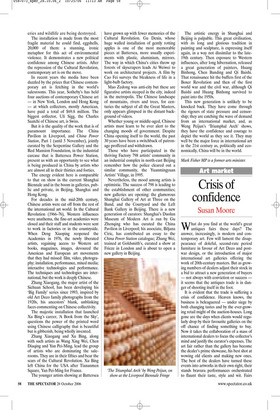Crisis of confidence
Susan Moore
What do you find at the world’s great antiques fairs these days? The answer, increasingly, is modern and contemporary art. Few will lament the disappearance of doleful, second-rate period furniture in favour of Art Deco and postwar design, or the introduction of major international art galleries offering the work of 20th-century masters. But as growing numbers of dealers adjust their stock in a bid to attract a new generation of buyers — not always with conviction or success it seems that the antiques trade is in danger of shooting itself in the foot.
It is evident that the trade is suffering a crisis of confidence. Heaven knows, the business is beleaguered — under siege by both changing tastes and by the ever-growing retail might of the auction-houses. Long gone are the days when clients would regularly drop by their favourite galleries on the off chance of finding something to buy. Now it takes the collaboration of a mass of international dealers to focus the collector’s mind and justify the curator’s expenses. The art fair rather than the gallery has become the dealer’s prime showcase, his best shot at wowing old clients and making new ones. The best of the dealers have turned these events into artworks in their own right, their stands bravura performances orchestrated to flaunt their taste, style and wit. Fairs present the public face of this once private business.
That face has seen a great deal of nipping and tucking of late. Take Grosvenor House, the grand old dame of the business and London’s flagship fair. After dropping the dateline to allow the introduction of modern and contemporary art, its organisers — the British Antique Dealers’ Association — took its makeover a radical stage further last year, creating Grosvenor Contemporary and encouraging dealers to exhibit recent pieces. Even its loan exhibition comprised exclusively contemporary applied arts. What a way for a trade association to promote a flagging business. If the BADA did not appear to believe in its members’ stock, one wondered, why should anyone else? No wonder that initiative was quietly dropped this year. It was replaced by Grosvenor Modern.
The slightest sense of apology — or was it defeatism? — even hovered uncomfortably around this year’s spectacular Biennale des Antiquaires in Paris, without doubt the most glamorous antiques fair in the world. To mark the fair’s triumphant return this September to the newly restored Grand Palais, cult designer François-Joseph Graf spent a mind-boggling 35 million euros on the installation alone. While his trompe l’oeil streetscape rather perversely imposed an austere NeoClassical straitjacket on one of the most exuberant Bel Epoque buildings in Paris, it achieved its goal in unifying the stands in an elegant, unfussy whole. But Graf also encouraged individual exhibitors to present contemporary art or adopt a modern, minimalist approach. The classical stand he designed for antiquities dealers Phoenix Fine Art, for instance, its walls and columns a deep blue-grey, was a masterclass in how to make objects sing.
At the stand of Jean-Marie Rossi at Aveline, however, I almost wept. M. Rossi is one of the most distinguished and respected dealers in 18th-century French furniture and decorative arts in the world. On his stand the likes of a grand Boulle bureau-plat, a pair of Saunier Japanese lacquer commodes, a Georges Jacob sitting-room suite and an exquisite little Nahl desk, a confection of mother-of-pearl and embossed silver leaves highlighted with green and gold, were all crowded against the walls à la storeroom while hanging uncomfortably close above them were canvases by Alex Katz, Robert Rauschenberg and Michael Rovner on loan from PaceWildenstein.
There is nothing particularly new about this sort of eclecticism that brings together ‘masterpieces’ old and new, and it can work amazingly well (one has only to note the recent price increase in Renaissance furniture that one could hardly give away a few years ago, and which looks sensational with modern art, to realise how many people are now doing this). Here, the experiment did neither any favours.
Across the Seine on the quai Anatole France is the imposing hôtel of the established family firm of Kugel, recently acquired and in itself a vote of confidence in the market for traditional works of art — not least mediaeval, Renaissance and baroque Schatzkammer pieces. In collaboration with dealer Axel Vervoordt, the gallery offered the private collection of the legendary Nicolas Landau, ‘Prince des antiquaires’ (until 10 November).
Landau informed the taste of a whole generation — Vervoordt among them through his mastery of juxtaposing works of art from different periods and civilisations according to form, material or subject matter, and by reinventing the cabinet of curiosities. Set out as part reconstruction and part improvisation of the Landau interiors, and embracing everything from antiquities and Renaissance sculpture to drawings, textiles and scientific instruments, the galleries looked sensational.
The place was full of collectors and dealers, outcrops of red dots everywhere. Some 200 pieces were sold in the first two days; some 200 more have changed hands since then. Dealers, just shout a bit louder, create a buzz around what you do, and do what you know best and believe in. Do anything but apologise.



























































































 Previous page
Previous page